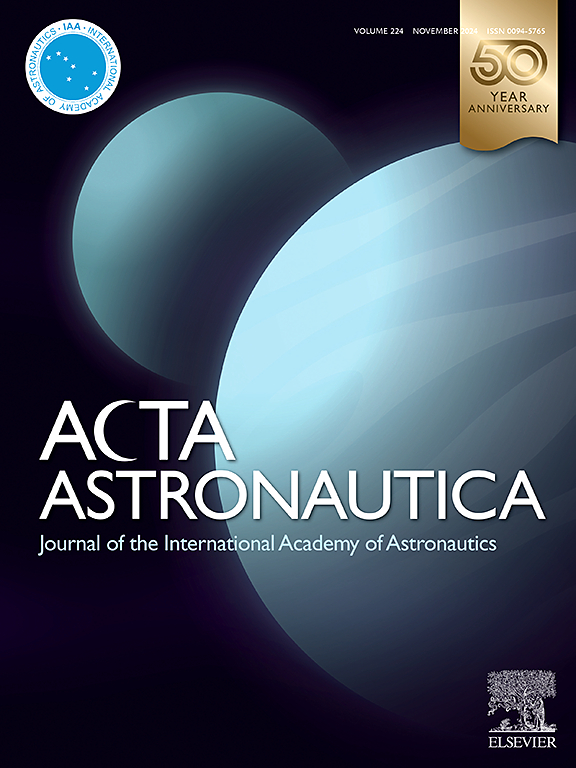旋转爆轰发动机下煤油/氧预雷管和煤油/空气热喷方案的设计与点火特性
IF 3.4
2区 物理与天体物理
Q1 ENGINEERING, AEROSPACE
引用次数: 0
摘要
旋转爆震发动机(RDE)具有结构简单、比冲高、体积小、放热率高等显著优势。然而,液体航空煤油的起爆仍然具有挑战性,因为它的点火能量要求相对较高。本研究提出了一种煤油/氧气预雷管的设计,包括一个双级轴向旋流器、一个点火腔和一个爆燃-爆轰过渡(DDT)腔。对预雷管的爆轰燃烧特性进行了实验研究。由于燃料雾化和爆轰过渡动力学的影响,该预雷管在当量比为0.6 ~ 0.7的范围内表现出最佳性能,爆震波压力可达6.5 MPa,波速约为1700 m/s。随着出口压力的降低,所需滴滴涕长度增加,波能下降;尽管如此,仍然获得了压力接近2.0 MPa的爆震波。在预雷管结构的基础上,引入了紊流环空,使煤油/空气混合物能够成功起爆。在此配置下,爆震波压力约为1.0 MPa。在低压出口环境中,煤油/空气点火系统以热喷射模式运行。采用预雷管和热射流两种方式启动RDE。结果表明,两种点火方式均能成功引发旋转爆震波。预雷管方法通过高能爆震波撞击、解耦和转捩,实现快速起爆,形成稳定的旋转爆震波。相比之下,热射流法依靠压缩波的逐渐积累来建立稳定的爆轰。与热射流方法相比,预雷管显著减少了起爆建立所需的时间。然而,一旦RDE达到稳态运行,无论采用何种点火方式,爆轰特性都会收敛。本文章由计算机程序翻译,如有差异,请以英文原文为准。

Design and ignition characteristics of kerosene/oxygen pre-detonator and kerosene/air hot-jet schemes under rotating detonation engine
The Rotating Detonation Engine (RDE) exhibits significant advantages including a simple configuration, high specific impulse, compact size, and elevated heat release rate. However, initiating detonation with liquid aviation kerosene remains challenging due to its relatively high ignition energy requirements. This study presents the design of a kerosene/oxygen pre-detonator, incorporating a dual-stage axial cyclone, an ignition cavity, and a deflagration-to-detonation transition (DDT) chamber. Experimental investigations were conducted to characterize the detonation combustion behavior of the pre-detonator. Due to the effects of fuel atomization and detonation transition dynamics, the pre-detonator demonstrated optimal performance within an equivalence ratio range of 0.6–0.7, achieving a detonation wave pressure of up to 6.5 MPa and a wave velocity around 1700 m/s. As the outlet pressure decreased, the required DDT length increased and the wave energy declined; nonetheless, detonation waves with pressures near 2.0 MPa were still achieved. Building on the pre-detonator configuration, a turbulent flow annulus was introduced to enable successful initiation using a kerosene/air mixture. Under this configuration, detonation wave pressures of approximately 1.0 MPa were realized. In low-pressure outlet environments, the kerosene/air ignition system operated in a Hot-jet mode. Both the pre-detonator and Hot-jet modes were employed to initiate the RDE. Results demonstrate that both ignition strategies can successfully initiate rotating detonation waves. The pre-detonator method facilitates rapid initiation through high-energy detonation wave impact, decoupling, and transition, leading to the formation of a stable rotating detonation wave. In contrast, the Hot-jet method relies on the gradual accumulation of compression waves to establish stable detonation. Compared to the Hot-jet approach, the pre-detonator significantly reduces the time required for detonation establishment. However, once the RDE reaches steady-state operation, the detonation characteristics converge regardless of the ignition method.
求助全文
通过发布文献求助,成功后即可免费获取论文全文。
去求助
来源期刊

Acta Astronautica
工程技术-工程:宇航
CiteScore
7.20
自引率
22.90%
发文量
599
审稿时长
53 days
期刊介绍:
Acta Astronautica is sponsored by the International Academy of Astronautics. Content is based on original contributions in all fields of basic, engineering, life and social space sciences and of space technology related to:
The peaceful scientific exploration of space,
Its exploitation for human welfare and progress,
Conception, design, development and operation of space-borne and Earth-based systems,
In addition to regular issues, the journal publishes selected proceedings of the annual International Astronautical Congress (IAC), transactions of the IAA and special issues on topics of current interest, such as microgravity, space station technology, geostationary orbits, and space economics. Other subject areas include satellite technology, space transportation and communications, space energy, power and propulsion, astrodynamics, extraterrestrial intelligence and Earth observations.
 求助内容:
求助内容: 应助结果提醒方式:
应助结果提醒方式:


